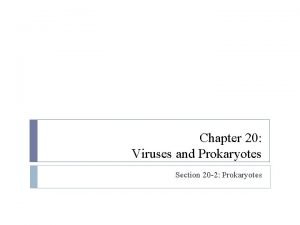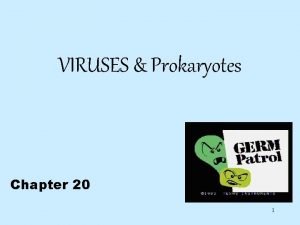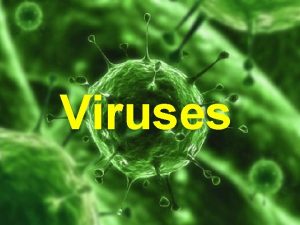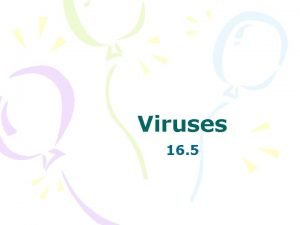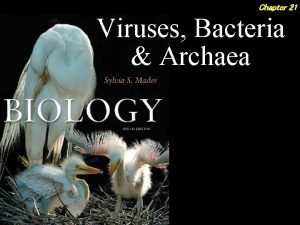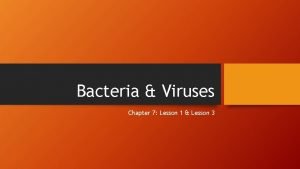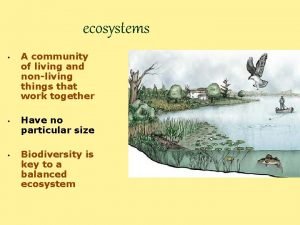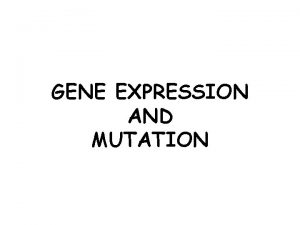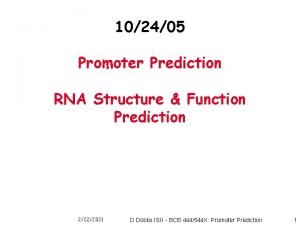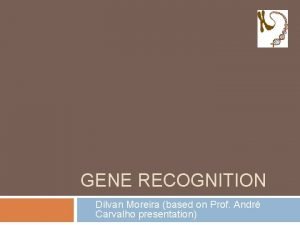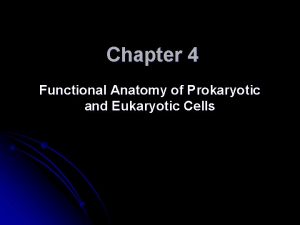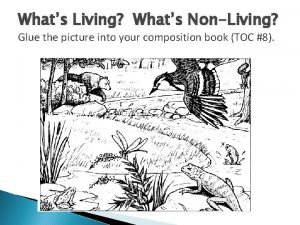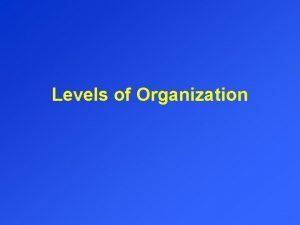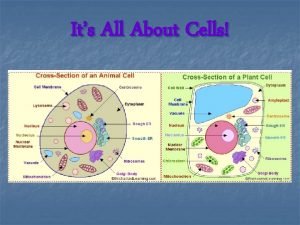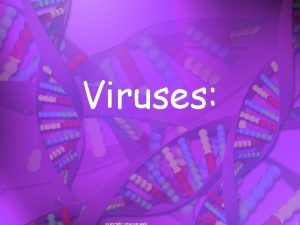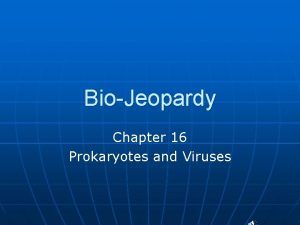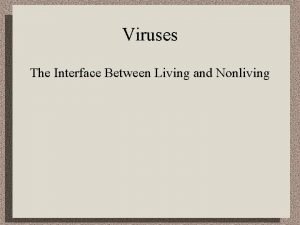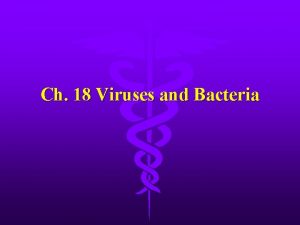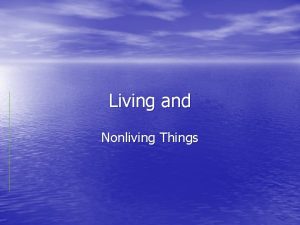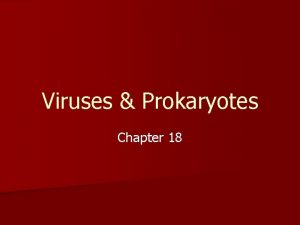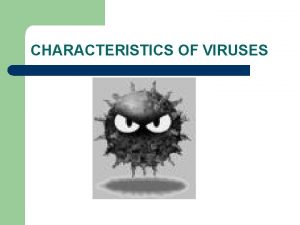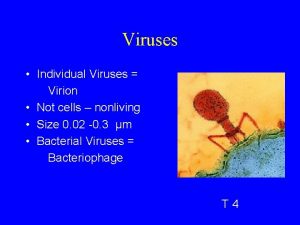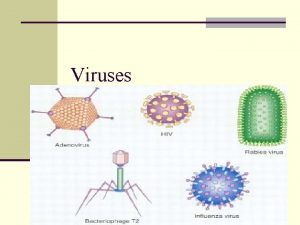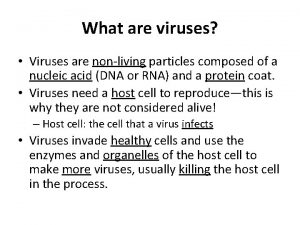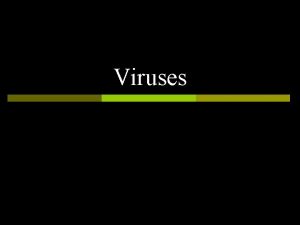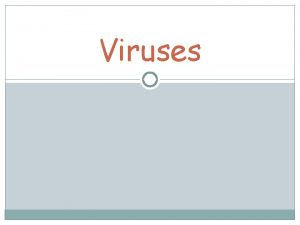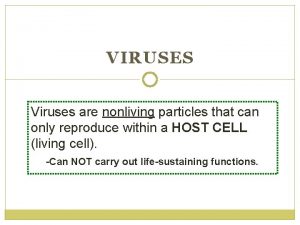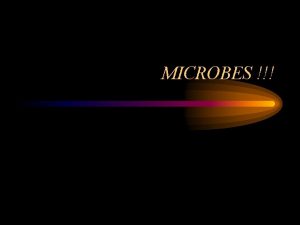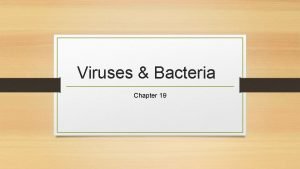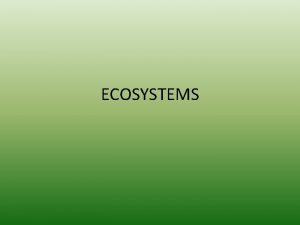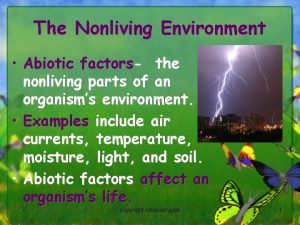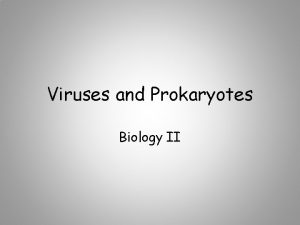Chapter 20 Viruses and Prokaryotes Viruses A nonliving






























- Slides: 30

Chapter 20 Viruses and Prokaryotes

Viruses �A nonliving (? ) particle made of proteins, nucleic acids, and sometimes lipids (fats) �Viruses only reproduce by infecting living cells �Most viruses can only be seen with an electron microscope �The first virus isolated was the tobacco mosaic virus in 1935

Structure of Viruses �Capsid – protein coat surrounding the virus �Genetic information – DNA or RNA �Viruses have specific proteins that bind to the host cell. Because of this they infect specific cells Influenza Virus

Bacteriophages �Viruses that infect bacteria are called bacteriophages

Viral Infections �Inside living cells, viruses use their genetic information to make multiple copies of themselves. Some viruses replicate immediately, while others are inactive in the host. � Lytic infection – the virus enters a cell, makes copies of itself and bursts the cell (lyse) � Lysogenic infection – the viral DNA/RNA is inserted into the host’s DNA and copies itself without immediately killing the cell

Lytic Infection (ex. T 4 bacteriophage) �The virus injects its DNA into the cell. �The cell then begins to make virus proteins and genetic material (nucleic acid). �The viral nucleic acid and proteins are then assembled into new virus particles �Viral proteins lyse (cut open) the cell �New viruses can infect other cells


Lysogenic Infection �Lysogenic infection –viral DNA/RNA is inserted into the host’s DNA and copies itself without instantly killing the cell �In each cell division the new cell is infected with the virus �When bacteriophage DNA is imbedded in the host’s DNA it is called a prophage �A trigger (heat, chemicals, radiation, etc) causes the prophage to remove itself from the host DNA and become a lytic infection.

RNA Viruses � 70% of viruses have RNA instead of DNA �RNA viruses cause colds, AIDS, cancer and others

The common cold �The virus is brought in the host cell (nose, etc. ) �The host cell makes viral protein and RNA �Within 8 hours the hose cell bursts and releases hundreds of new viruses

HIV �HIV is a retrovirus – the genetic information is copied from the RNA to DNA �The viral DNA remains inactive for many cell divisions �When activated, the viruses damage the host’s immune system.

VIRUSES vs. CELLS �Viruses have many characteristics of cells �Viruses depend on living things and therefore were not likely to be the first living organisms.

Prokaryotes �Prokaryote – unicellular organism without a nucleus �DNA is found in the cytoplasm � 2 Domains of prokaryotes 1) Bacteria -Live almost everywhere (fresh and salt water, land, other organisms -Have a cell wall made of peptidoglycan (sugar and amino acids) -some have flagella and second cell membrane 2) Archea -DNA is more similar to eukaryotes -many live in harsh environments (digestive tract, hot spring

Structure and Function �Prokaryotes vary in their size and shape, the way they move and the way the use energy �Shapes – �Movement �Some don’t move �Flagella �Move in slime they make

Obtaining Energy

Growth and Reproduction �Binary fission – a prokaryote replicates its DNA and divides in half, producing two identical cells - Asexual reproduction - Can occur every 20 minutes �Endospore – a structure produced in unfavorable conditions - A thick internal wall encloses the DNA and cytoplasm

How do prokaryotes evolve? �Mutation – random changes in DNA -passed on to daughter cells -one of the main way prokaryotes evolve �Conjugation – a hollow bridge forms between two bacterial cells and genetic material moves from one cell to the other -increases genetic diversity -many times a gene that enables the bacteria to live in a new environment is transferred in form of a plasmid (circular piece of DNA)

The Importance of Prokaryotes �Decomposers – assist in breaking down dead organisms �Producers – food chains are dependent on bacteria for producing food � 1 cyanobacterium (Prochlorococcus) is the most abundant photosynthetic organism – makes over ½ of food in the open ocean �Nitrogen Fixers – converts nitrogen into a form plants use (N 2 to NH 3) � 90% of the nitrogen organisms use comes from fixation

Human Uses of Prokaryotes �Production of Food – yogurt, cheese, vinegar �Clean oil spills �Remove human waste and poison from water �Medicine – synthesize drugs – insulin, human growth hormone �Digestion

Bacterial Diseases �Pathogen = a virus or bacteria that causes disease �Bacteria cause disease by 1) Destroying living cells directly of cause tissue damage when they provoke an immune response from the host - Tuberculosis (TB) is inhaled into the lungs and the immune response destroys tissue 2) Release toxins that upset the normal activities of the host - Botulism – food poisoning tetanus – causes lockjaw, muscle spasms

Bacterial Diseases

Controlling Bacteria �Physical Removal – hand washing removes bacteria �Disinfectants - chemicals that kill bacteria �Food Storage – - refrigeration/freezing slows the growth �Food Procession – boiling, frying, steaming kills bacteria �Sterilization by Heat – kills bacteria

Controlling Bacteria (Cont. ) �Vaccines – a preparation of weakened or killed pathogen or inactivated toxin - The vaccine stimulates the body to produce immunity to a specific disease �Antibiotics – block the growth and reproduction of bacteria - Disrupt proteins or cell processes specific to bacterial cells - Do not harm host’s cells

Viral Diseases �Viruses also cause disease by 1) destroying cells directly 2) interrupting cellular processes

Prevention and Treatment for Viral Diseases �Preventing viral diseases Vaccines 2) Personal hygiene 1) -wash hands -avoid sick people -cough into a tissue or sleeve �Antibiotics DO NOT WORK for viral infections �There a handful of antiviral drugs - Speed recovery from flu/may reduce spread of HIV

Emerging Diseases �Emerging diseases = an unknown disease that appears in a population for the first time or a well-known disease that has become harder to control �Pathogens that cause emerging diseases are threatening because humans have little or no resistance for them and control methods have not been developed �Human populations once isolated are now connected – quick spread of disease

Emerging Diseases

Superbugs �Use of antibiotics has lead to bacteria that are resistant to antibiotics �Penicillin killed many infections in the 1940 s when it was introduced. Now is has lost effectiveness �Bacteria that are resistant to penicillin reproduce and pass resistance on through conjugation �MRSA – skin infection spread by close contact

New Viruses �Genetic makeup of viruses changes quickly and allows a virus to jump form one species to another. - AIDS may have jumped from nonhuman primates - “Bird flu” is a concern because it may jump to humans and is similar to some of the most deadly human versions of the flu

Prions �Prion – protein particle that causes disease - misfolded proteins in the brain that cause a chain reaction of misfolding in other normal proteins they contact, clogging the brain tissue and causing disease. Sheep – scrapies Cow – mad cow
 Chapter 20 viruses and prokaryotes
Chapter 20 viruses and prokaryotes Chapter 20 viruses and prokaryotes
Chapter 20 viruses and prokaryotes Section 1 studying viruses and prokaryotes
Section 1 studying viruses and prokaryotes Why are viruses considered nonliving?
Why are viruses considered nonliving? Why are viruses considered nonliving
Why are viruses considered nonliving M7rh5si5154 -site:youtube.com
M7rh5si5154 -site:youtube.com /watch?v=dckvspcd8gs
/watch?v=dckvspcd8gs Chapter 21 viruses and bacteria
Chapter 21 viruses and bacteria Bacteria and viruses chapter 7 lesson 1 answer key
Bacteria and viruses chapter 7 lesson 1 answer key Study guide chapter 18 section 1 bacteria
Study guide chapter 18 section 1 bacteria Ecosystems examples
Ecosystems examples Living and nonliving things venn diagram
Living and nonliving things venn diagram Parasitism
Parasitism Non living things in grasslands
Non living things in grasslands Living and nonliving characteristics
Living and nonliving characteristics Things in ecosystem
Things in ecosystem Diff between prokaryotes and eukaryotes
Diff between prokaryotes and eukaryotes Prokaryotes and eukaryotes
Prokaryotes and eukaryotes Prokaryotes and eukaryotes
Prokaryotes and eukaryotes Multiple choice questions on prokaryotes and eukaryotes
Multiple choice questions on prokaryotes and eukaryotes Gene prediction in prokaryotes and eukaryotes
Gene prediction in prokaryotes and eukaryotes Repressible operon
Repressible operon Prokaryotes and eukaryotes
Prokaryotes and eukaryotes Which organisms are prokaryotes
Which organisms are prokaryotes Functional anatomy of prokaryotic and eukaryotic cells
Functional anatomy of prokaryotic and eukaryotic cells Section 19-3 diseases caused by bacteria and viruses
Section 19-3 diseases caused by bacteria and viruses Whats non living things
Whats non living things Nonliving solid with crystal like properties
Nonliving solid with crystal like properties What is the smallest part of a plant
What is the smallest part of a plant Are chromosomes living or nonliving
Are chromosomes living or nonliving Is moss living or non-living
Is moss living or non-living

